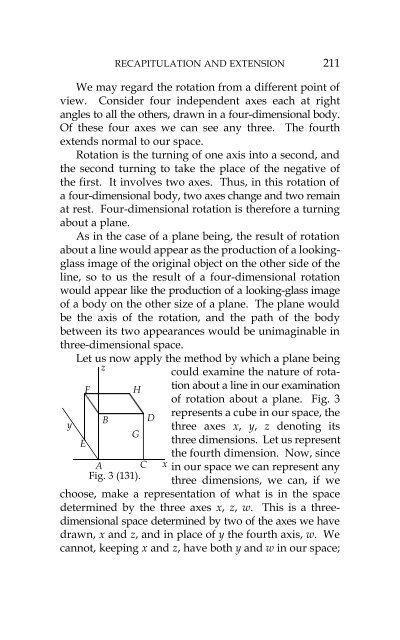Create successful ePaper yourself
Turn your PDF publications into a flip-book with our unique Google optimized e-Paper software.
RECAPITULATION AND EXTENSION 211<br />
We may regard the rotation from a different point of<br />
view. Consider four independent axes each at right<br />
angles to all the others, drawn in a four-dimensional body.<br />
Of these four axes we can see any three. <strong>The</strong> fourth<br />
extends normal to our space.<br />
Rotation is the turning of one axis into a second, and<br />
the second turning to take the place of the negative of<br />
the first. It involves two axes. Thus, in this rotation of<br />
a four-dimensional body, two axes change and two remain<br />
at rest. Four-dimensional rotation is therefore a turning<br />
about a plane.<br />
As in the case of a plane being, the result of rotation<br />
about a line would appear as the production of a lookingglass<br />
image of the original object on the other side of the<br />
line, so to us the result of a four-dimensional rotation<br />
would appear like the production of a looking-glass image<br />
of a body on the other size of a plane. <strong>The</strong> plane would<br />
be the axis of the rotation, and the path of the body<br />
between its two appearances would be unimaginable in<br />
three-dimensional space.<br />
Let us now apply the method by which a plane being<br />
z<br />
could examine the nature of rota-<br />
F H tion about a line in our examination<br />
of rotation about a plane. Fig. 3<br />
represents a cube in our space, the<br />
y<br />
B D<br />
three axes x, y, z denoting its<br />
G<br />
E<br />
three dimensions. Let us represent<br />
the fourth dimension. Now, since<br />
A C x in our space we can represent any<br />
Fig. 3 (131).<br />
three dimensions, we can, if we<br />
choose, make a representation of what is in the space<br />
determined by the three axes x, z, w. This is a threedimensional<br />
space determined by two of the axes we have<br />
drawn, x and z, and in place of y the fourth axis, w. We<br />
cannot, keeping x and z, have both y and w in our space;






![[PDF] Prolegomena](https://img.yumpu.com/16774951/1/190x245/pdf-prolegomena.jpg?quality=85)









